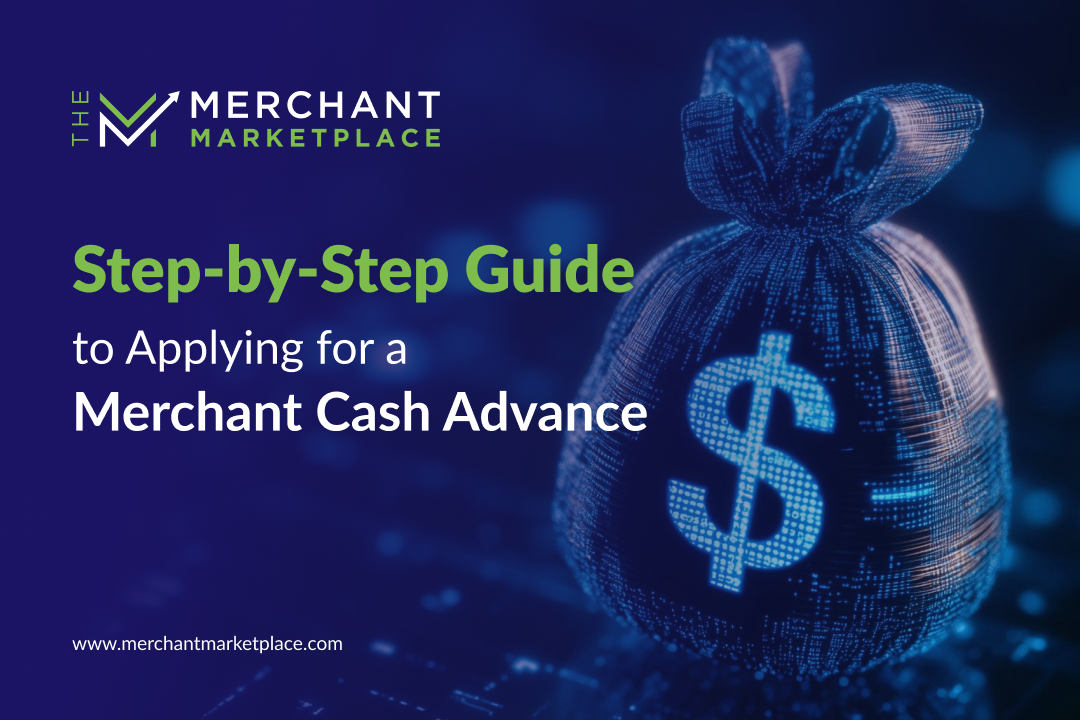When cash is tight, a Merchant Cash Advance (MCA) can feel like a lifesaver. Think of it less like a traditional loan and more like cashing in a chunk of your future sales today.
Business owners dig MCAs because they’re quick, flexible, and payments move with your sales, no dragging through bank hoops.
This guide breaks down the MCA process step by step, so you’ll know what docs to prep, how to size up offers, and keep repayments from wrecking your cash flow.
Understanding Merchant Cash Advances
Definition of an MCA and how it works
A Merchant Cash Advance means a financing company gives you a lump sum of cash right now, in exchange for a portion of your future credit card (or debit) sales. You’re essentially selling future receivables. The provider takes their cut automatically, via a holdback on your daily sales, until you’ve repaid the agreed total.
Unlike a fixed-interest loan, there’s no set monthly payment, you pay more when sales are up, less when they’re down.
How MCAs differ from traditional loans
Traditional loans hit you with collateral, credit checks, and set monthly payments, but MCAs play by your sales. Repayments come as a slice of daily sales, use factor rates instead of interest, and since they’re not technically loans, standard rate limits don’t apply, making them usually more expensive.
Key terms to know
- Factor rate: A multiplier (e.g. 1.2, 1.3) used to compute how much you’ll repay. If you borrow $10,000 with a 1.3 factor, you owe $13,000.
- Holdback percentage: The share of your card sales the provider takes, daily or weekly, until the advance is paid off (e.g. 10%, 15%, even up to 20% or more).
- Repayment structure / retrieval rate: The mechanics of how money is pulled (via merchant account, ACH from your bank, etc.). This links to holdback and how you pay back over time.
Step 1: Assess Your Business Needs
Identify why you need quick funding
Before you dive in, ask: What’s pushing you toward external cash? Is it emergency repairs, a spike in inventory demand, meeting payroll, or bridging a shortfall in receivables? Be crystal clear.
Evaluate whether an MCA fits your business model and cash flow
If your business handles steady credit/debit card transactions, an MCA might work. If sales are sporadic or you deal more in cash, repayment might choke your liquidity. Also, if your margins are tight, taking a slice of future sales might push you into negative territory.
Step 2: Check Eligibility Requirements
To get approved for an MCA, lenders look for certain signals that your business can deliver on repayments.
Common requirements MCA providers look for
- Consistent sales: Because repayment is tied to card volume, strong card receipts are key.
- Minimum time in business: Many require at least a few months (3–6) of consistent operations; some demand longer.
- Basic revenue thresholds: They’ll want to see a minimum monthly or annual volume.
- Credit score relevance: While MCAs don’t hinge on perfect credit, providers often check your personal or business credit. A decent score helps in negotiating better terms or lowering factor rates.
Credit matters less than it does with a traditional loan, but a wrecked credit history can still raise red flags.
Step 3: Gather Necessary Documentation
To speed up your application, prepare early. Here’s what you’ll likely need.
Typical documents MCA providers may request
- Recent bank statements (3–6 months): To show cash flow trends, deposits, withdrawals.
- Merchant processing statements: Reports from your card processor showing volume, chargebacks, daily sales.
- Basic business information: EIN or business registration, licenses, address, contact info.
- Identification & ownership details: Owner’s ID, SSN or equivalent, ownership breakdowns, sometimes personal financial statements.
Tips to prepare paperwork in advance for faster approval
- Order bank statements ahead, ensure they’re clean (no huge, odd withdrawals)
- Make sure your merchant account statements line up with your records.
- Have your business registration, tax IDs, licenses ready
- Keep your ownership documents, IDs, proofs of residence handy
Step 4: Choose the Right MCA Partner
That’s why many choose Merchant Marketplace, simple, transparent, and business-friendly. Still, check key factors if opting for other lenders, such as clear terms, solid support, and repayment that fits your cash flow.
How to find reputable MCA companies
Check reviews on Google, BBB, and forums, hit up other small business owners for referrals, watch for complaints or legal problems, and confirm the provider posts clear terms and disclosures.
Factors to compare
- Factor rates and fees: Even a small difference (say 1.25 vs 1.35) can cost you thousands
- Funding speed: How fast do they promise money after approval? Same day? 1–2 days
- Reputation and reviews: How do past clients rate their transparency, customer service, hidden fees
- Customer service support: How responsive are they when you have a question or dispute
- Fine print: Watch for hidden clauses: prepayment penalties, extra fees, catch-clauses, auto-renewals
Don’t just chase the lowest factor rate; balance cost + trust + flexibility matters.
Step 5: Submit Your Application
Once you’ve chosen one or more providers, you apply.
How to fill out the application accurately
You need to enter your business name, tax IDs, and address correctly, make sure your bank and processing statements match, keep dates and numbers consistent, and stay conservative when sharing sales or projections.
What information is typically required
Your business name and type (LLC, sole prop, etc.), business address and contact info, who owns what share, bank details for deposits, sales history from your card processor or POS, financial records, and owner info like ID, SSN, and address.
Common mistakes to avoid that could delay approval
Avoid typos or mismatched names, incomplete or missing statements, misstating revenue, missing IDs or signatures, and using outdated documents.
Step 6: Review and Accept Offer
If you get an offer, read carefully.
Understanding the offer terms
Check the factor rate and total repayment, holdback percentage, expected (variable) repayment period, any fees or hidden costs, and rules for prepayment or default.
Calculating the total cost of the advance
Multiply the advance by the factor rate. Then consider how quickly you’ll repay (which affects your effective rate). If you repay in 3 months, your effective APR may be huge.
Questions to ask before signing
- Are there any fees not disclosed up front?
- What happens if daily sales drop drastically?
- Is there any flexibility or pause for hardship?
- Can I prepay, and will that reduce the cost?
- What rights do they have (e.g. UCC-1 lien) in default?
What accepting the offer legally commits you to
Once you sign, the provider usually has rights to automatically pull from your merchant account or bank account. Default can lead to asset seizure under UCC lien, or forced collections.
Step 7: Receive Funding and Start Repayment
How quickly funds are typically disbursed
Many MCA programs deliver funds in 24–72 hours after approval. Some claim same-day funding if paperwork is in order.
How repayment works
From the moment funding hits your account, the holdback kicks in. A percentage of your card sales (or debits) is withheld daily/weekly until you’ve repaid the total advance + fees.
If your sales slump, the daily amount drops; if sales spike, provider takes more that day. There’s no fixed schedule like a loan.
Monitoring cash flow to stay on track
Keep an eye on daily or weekly sales versus holdback, plan for slower periods to cover expenses, keep a bank buffer, and watch for sudden spikes in deductions, challenge them if they seem too high.
Step 8: Manage Your MCA Responsibly
Strategies to avoid cash flow crunch during repayment
Maintain an emergency cash reserve, avoid taking another MCA too soon, boost margins or cut costs during repayment, and be conservative with revenue projections.
Tips to build business credit for better financing in the future
Pay existing loans on time, use and repay small credit lines, keep your finances organized, and consider a traditional business loan once your business is stronger.
When (and when not) to consider a second MCA
Only think of a second one if your first is nearly paid, or only if your cash flow can absorb the new holdback. Doing them back-to-back is a red flag, you may be stuck in a debt trap.
Alternatives to MCAs
While MCAs are fast, they’re not always the best. Here are some other fast capital routes:
- Business line of credit: gives you flexibility, often lower interest
- Invoice factoring: you sell invoices to get instant cash. It is better if your business issues invoices rather than relies on card sales
- Short-term business loans or microloans: fixed interest and schedul
- Merchant lines built into payment processors: e.g. Stripe Capital, where the processor offers advances based on your history (if you’re already using their system).
Often these are cheaper or more sustainable in the long term but check them first.
Conclusion
Applying for a Merchant Cash Advance isn’t rocket science but doing it smartly makes all the difference. You’ve got to plan, compare, and understand the fine print. Don’t blindly grab the first offer.
You now know what an MCA is, how it’s different from a traditional loan, the eligibility checks, the docs you’ll need, how to shop wisely, how to submit the app, how to review offers, how repayment works, and how to manage it smart so you don’t choke your business.
At the end of the day, funding is a tool, not a cure. Use it in service of your business goals. If you ever need help comparing offers, let Merchant Marketplace help you.




